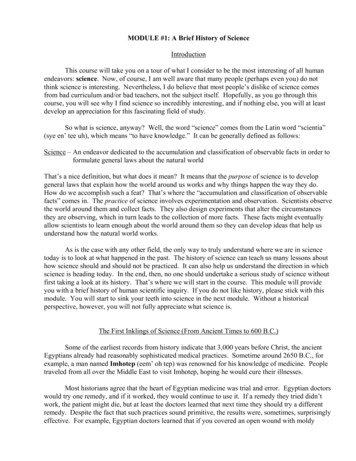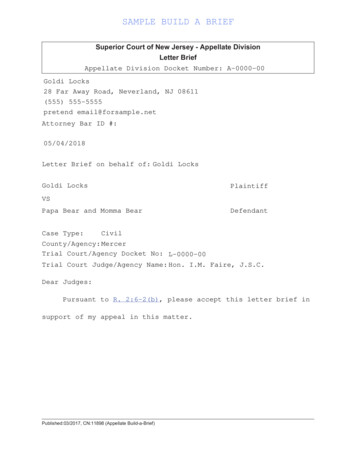
Transcription
MODULE #1: A Brief History of ScienceIntroductionThis course will take you on a tour of what I consider to be the most interesting of all humanendeavors: science. Now, of course, I am well aware that many people (perhaps even you) do notthink science is interesting. Nevertheless, I do believe that most people’s dislike of science comesfrom bad curriculum and/or bad teachers, not the subject itself. Hopefully, as you go through thiscourse, you will see why I find science so incredibly interesting, and if nothing else, you will at leastdevelop an appreciation for this fascinating field of study.So what is science, anyway? Well, the word “science” comes from the Latin word “scientia”(sye en’ tee uh), which means “to have knowledge.” It can be generally defined as follows:Science – An endeavor dedicated to the accumulation and classification of observable facts in order toformulate general laws about the natural worldThat’s a nice definition, but what does it mean? It means that the purpose of science is to developgeneral laws that explain how the world around us works and why things happen the way they do.How do we accomplish such a feat? That’s where the “accumulation and classification of observablefacts” comes in. The practice of science involves experimentation and observation. Scientists observethe world around them and collect facts. They also design experiments that alter the circumstancesthey are observing, which in turn leads to the collection of more facts. These facts might eventuallyallow scientists to learn enough about the world around them so they can develop ideas that help usunderstand how the natural world works.As is the case with any other field, the only way to truly understand where we are in sciencetoday is to look at what happened in the past. The history of science can teach us many lessons abouthow science should and should not be practiced. It can also help us understand the direction in whichscience is heading today. In the end, then, no one should undertake a serious study of science withoutfirst taking a look at its history. That’s where we will start in the course. This module will provideyou with a brief history of human scientific inquiry. If you do not like history, please stick with thismodule. You will start to sink your teeth into science in the next module. Without a historicalperspective, however, you will not fully appreciate what science is.The First Inklings of Science (From Ancient Times to 600 B.C.)Some of the earliest records from history indicate that 3,000 years before Christ, the ancientEgyptians already had reasonably sophisticated medical practices. Sometime around 2650 B.C., forexample, a man named Imhotep (eem’ oh tep) was renowned for his knowledge of medicine. Peopletraveled from all over the Middle East to visit Imhotep, hoping he would cure their illnesses.Most historians agree that the heart of Egyptian medicine was trial and error. Egyptian doctorswould try one remedy, and if it worked, they would continue to use it. If a remedy they tried didn’twork, the patient might die, but at least the doctors learned that next time they should try a differentremedy. Despite the fact that such practices sound primitive, the results were, sometimes, surprisinglyeffective. For example, Egyptian doctors learned that if you covered an open wound with moldy
2Exploring Creation With General Sciencebread, the wound would heal quickly and cleanly. As a result, most Egyptian doctors applied moldybread to their patients’ wounds. Modern science tells us that certain bread molds produce penicillin, achemical that kills germs that infect wounds! Thus, even though the Egyptian doctors knew nothingabout germs, they were able to treat wounds in a way that helped avoid infections!Another example of the surprisingly effective art of ancient Egyptian medicine can be seen inthe way they treated pain. In order to relieve a patient who was in pain, Egyptian doctors would feedthe patient seeds from a flowering plant called the poppy. Eating these poppy seeds seemed to relievethe patient’s pain. Modern science tells us why this worked. Poppy seeds contain both morphine andcodeine, which are excellent pain-relieving drugs still used today!Mold photo IconexAgency: www.shutterstock.comFIGURE 1.1Natural Remedies Used By Ancient EgyptiansSince some bread molds produce germ-fightingchemicals, they can aid in healing wounds.Poppy photo TihisAgency: www.shutterstock.comPoppy seeds (and other parts of the plant)contain chemicals that help relieve pain.Why was Egyptian medicine advanced compared to the medicine of other ancient nations?Well, at least one reason was the Egyptian invention of papyrus (puh pye’ rus).Papyrus – An ancient form of paper, made from a plant of the same nameAs early as 3,000 years before Christ, Egyptians took thin slices of the stem of the papyrus plant, laidthem crosswise on top of each other, moistened them, and then pressed and dried them. The result wasa form of paper that was reasonably easy to write on and store.The invention of this ancient form of paper revolutionized the way information was transmittedfrom person to person and generation to generation. Before papyrus, Egyptians, Sumerians, and otherraces wrote on clay tablets or smooth rocks. This was a time-consuming process, and the productswere not easy to store or transport. When Egyptians began writing on papyrus, all of that changed.
Module 1: A Brief History of Science3Papyrus was easy to roll into scrolls. Thus, Egyptian writings became easy to store and transport. Asa result, the knowledge of one scholar could be easily transferred to other scholars. As thisaccumulated knowledge was passed down from generation to generation, Egyptian medicine becamethe most respected form of medicine in the known world!Although the Egyptians were renowned for their medicine and for papyrus, other cultures hadimpressive inventions of their own. Around the time that papyrus was first being used in Egypt, theMesopotamians were making pottery using the first known potter’s wheel. Not long after, horsedrawn chariots were being used. As early as 1,000 years before Christ, the Chinese were usingcompasses to aid themselves in their travels. The ancient world, then, was filled with inventions that,although they sound commonplace today, revolutionized life during those times. These inventions arehistory’s first inklings of science.As you progress through this course, you will see that it is divided into sections. Usually, at theend of each section, you will find one or two “On Your Own” questions. You should answer thesequestions as soon as you come to them in the reading. They are designed to make you think aboutwhat you have just read. These questions are often not very easy to answer, because you cannotsimply look back over the reading and find the answer. You must think about what you have learnedand make some conclusions in order to answer the question. You will find your first such questionbelow. Answer it on a separate sheet of paper and then check your answer against the solutionprovided at the end of this module.ON YOUR OWN1.1 Although the ancient Egyptians had reasonably advanced medical practices for their times, andalthough there were many inventions that revolutionized life in the ancient world, most historians ofscience do not think of Egyptian doctors and ancient inventors as scientists. Why? (Hint: Look at theentire definition of science.)True Science Begins to Emerge (600 B.C. to 500 A.D.)As far as historians can tell, the first true scientists were the ancient Greeks. Remember,science consists of collecting facts and observations and then using those observations to explain thenatural world. Although many cultures like the ancient Egyptians, Mesopotamians, and Chinese hadcollected observations and facts, they had not tried to use those facts to develop explanations of theworld around them. As near as historians can tell, that didn’t happen until the 6th century B.C., withthree individuals known as Thales, Anaximander (an axe’ uh man der), and Anaximenes (an axe’ uhme’ neez). Many historians view these three individuals as humanity’s first real scientists.Thales studied the heavens and tried to develop a unifying theme that would explain themovement of the heavenly bodies (the planets and stars). He was at least partially successful, ashistory tells us he used his ideas to predict certain planetary events. For example, he gained a greatreputation throughout the known world when he correctly predicted the “short-term disappearance ofthe sun.” What he predicted, of course, was a solar eclipse, an event in which the moon movesbetween the earth and the sun, mostly blocking the sun from view.
4Exploring Creation With General ScienceAnaximander was probably a pupil of Thales. He was much more interested in the study oflife, however. As far as we know, he was the first scientist who tried to explain the origin of thehuman race without reference to a creator. He believed that all life began in the sea, and at one time,humans were actually some sort of fish. This idea was later resurrected by other scientists, mostnotably Charles Darwin, and is today called evolution. Later on in this course, I will discuss evolution,showing how the data we currently have do not support it.Anaximenes was probably an associate of Anaximander. He believed that air was the mostbasic substance in nature. In fact, he believed all things were constructed of air. When air is thinnedout, he thought, it grows warm and becomes fire. When air is thickened, he thought, it condenses intoliquid and solid matter. We know, of course, that these ideas are wrong. Nevertheless, his attempts toexplain all things in nature as being made of a single substance led to one of the most importantscientific ideas introduced by the Greeks: the concept of atoms.Leucippus (loo sip’ us) was a Greek scientist who lived perhaps 100 to 150 years afterAnaximenes. Although little is known about him, historians believe that he built on the concepts ofAnaximenes and proposed that all matter is composed of little units called “atoms.” As a result,Leucippus is known as the father of atomic theory. The works of his student Democritus (duh mah’crit us) are much better preserved.Democritus used the following illustration to communicate his ideas about atoms: Think aboutwalking towards a sandy beach. When you are a long way from the beach, the sand looks like asmooth, yellow blanket. As you get closer to the beach, you might notice that there are bumps andvalleys in the sand, but the sand still looks solid. When you reach the beach and actually kneel downand examine the sand, you find that it is not solid at all. Instead, it is composed of tiny particles called“grains.”Democritus believed that all matter was similar to sand. Even though a piece of wood appearsto be solid, it is, in fact, made up of little individual particles that Democritus and his teacher calledatoms. Perform the following experiment to see the kind of observation best explained using theconcept of atoms.EXPERIMENT 1.1Density in NatureSupplies Vegetable oilWaterMaple or corn syrupA grapeA piece of corkAn ice cubeA small rockA tall glassEye protection such as goggles or safety glassesIntroduction: Observations such as the ones you will make in this experiment are easy to explainwhen you assume the existence of atoms.
Module 1: A Brief History of Science5Procedure:1.2.3.4.Take the glass and fill it about ¼ of the way with the vegetable oil.Add an equal amount of water to the glass.Add an equal amount of maple syrup to the glass.Now look at the glass from the side. What do you see? In your laboratory notebook, make asketch of what you see.5. Drop the rock, the grape, the ice cube, and the piece of cork into the glass. Now what do you see?Add the rock, grape, ice cube, and cork to the sketch you made in step 4.6. Clean up your mess and put everything away.What did you see in the experiment? If everything went well, you should have seen that theliquids formed layers in the glass. The vegetable oil formed a layer on top, the water layer was in themiddle, and the syrup layer was at the bottom. In addition, the cork should have floated on top of thevegetable oil; the ice cube should have floated on top of the water layer; the grape should have floatedon top of the syrup layer, and the rock should have sunk to the bottom of the glass.How in the world is this experiment evidence for the existence of atoms? Well, according toDemocritus, the water, vegetable oil, and syrup are all made of individual particles called atoms. Theway those atoms are packed together will determine each object’s characteristics. For example,assuming that the atoms in water are packed more closely than those in vegetable oil, the water will beable to pass between the atoms in the vegetable oil, sinking to the bottom of the glass. In the sameway, the atoms in the syrup are more tightly packed than those in water or vegetable oil, so the syrup’satoms were able to fall in between the atoms of both the vegetable oil and the water to land at thebottom of the glass.Even solid objects are made up of atoms. Thus, the cork’s atoms are packed together veryloosely. As a result, the cork doesn’t have much weight and cannot push its way through the atoms inthe vegetable oil. That’s why it floats on top of the vegetable oil. The atoms in the ice cube, however,are more tightly packed and make the ice cube heavy enough to push the atoms in vegetable oil out ofthe way. This allows it to sink through the vegetable oil. However, they are not tightly packed enoughto allow the ice cube to push through the atoms in the water.If substances were not composed of smaller particles (like atoms), it would be hard tounderstand how one substance could pass through another substance. However, if you imagine everysubstance to be made up of little grains (like sand), then passing through a substance would just be amatter of fitting between the grains or pushing the grains out of the way. Thus, if you assume theexistence of atoms, results of experiments like the one you just did are easy to understand.At this point, I am done discussing the experiment. Now that you know what the experimentshows, you can write a summary of it in your laboratory notebook. Write a brief description of whatyou did, followed by a discussion of what you learned. The goal you should have in mind is thatsomeone who has never read this book should be able to read your laboratory notebook and understandwhat you did and what you learned. You should do this for every experiment.Democritus was not well received in his time, but later scientists picked up on his ideas andrefined them. Today, we know that all matter is made up of atoms. Indeed, today we can actually
6Exploring Creation With General Sciencecalculate how atoms pack together to make a given substance. This allows us to understand theconcept of density, which describes how tightly packed the matter in a substance is. The more tightlypacked the matter that makes up a substance, the higher its density. In your experiment, then, thesyrup had a higher density than the water.FIGURE 1.2DemocritusImage in the public domainWe don’t really know what Democrituslooked like, but this is how Dutch painterHendrick ter Brugghen imagined him. He wascalled the “Laughing Philosopher,” but no oneis exactly sure why. Some suggest it isbecause he considered cheerfulness to be animportant goal in life. Others suggest it isbecause he was prone to laugh when hethought someone else was making a stupidmistake.Although Democritus was right about allthings being composed of atoms, he waswrong about most of the details regardingwhat atoms are really like. He believed, forexample, that atoms are indestructible. Wenow know that is wrong. After all, the atomicbomb and nuclear energy are both based onour ability to split atoms. He also thought thatatoms were distinguished based on their shapeand size. We now know it is a lot morecomplicated than that.While Democritus was wrong on many of the details related to atoms, there was one detail hegot right. He thought that atoms were in constant motion. For example, if a glass of water is sitting ona table, you might think the water is not in motion. To some extent, you would be right. After all, thewater in the glass stays in the glass, and the glass itself stays on the table. At the same time, however,the atoms that make up the water are in constant motion. They move around within the confines of theglass, rebounding off the walls of the glass and colliding into each other. You might find it hard tobelieve that the atoms within a glass of water are in motion when the water itself is not. However, youmight find it a little easier to believe after performing the following experiment.EXPERIMENT 1.2Atomic MotionSupplies: Two glass canning jars or peanut butter jars (both the same size)Food coloring (any color)A pan and stove to boil water, and a hotpad to hold the panEye protection such as goggles or safety glasses
Module 1: A Brief History of Science7Introduction: By seeing how food coloring gets distributed through two jars of water at differenttemperatures, you will collect evidence for the fact that atoms are in constant motion.Procedure:1. Boil some water. You need to boil enough to fill one of the jars about halfway.2. Once the water is boiling, take it off the stove (use the hotpad!) and pour it into one of the jars.Pour in enough water so that the jar is about half full.3. Fill the other jar about halfway with cold water from the tap.4. Wait until the water in each jar is still.5. Drop a single drop of food coloring into each jar. Observe what happens over the next severalminutes. Record in your laboratory notebook the difference between what happened in each jar.6. OPTIONAL: Let the jar with the cold water sit out for a full day. Record what the jar looks likeafterward.7. Clean up your mess.What did you see in the experiment? If everything went well, you should have seen the drop offood coloring mix rapidly with the hot water, coloring the entire jar of water relatively quickly. In thejar of cold water, however, the food coloring should not have mixed well at all. Why was there adifference? The answer is found in the motion of atoms. When a substance is hot, its atoms movefaster than when it is cold. When you added food coloring to the cold water, then, the atoms in thewater collided with the atoms in the food coloring, moving them around. However, since the atoms inthe cold water were not moving very quickly, the food coloring did not get moved around much, so itdid not mix well with the water. Given enough time, the food coloring will mix well with the water,eventually becoming evenly distributed throughout the jar. When you added the food coloring to thehot water, however, the collisions between the atoms in the food coloring and the atoms in the waterwere much more violent, because the atoms in the water were moving much more quickly. Thismoved the atoms in the food coloring around quite a bit, spreading them out evenly throughout the jarof water in a short amount of time.In the end, then, even though Democritus was wrong about a great many things, he was rightabout two important ideas. First, all things are, indeed, composed of atoms. Second, those atoms arein constant motion. Now as I said before, Democritus was not well received in his time. Most of hisfellow scientists rejected his ideas. In fact, the whole idea of the existence of atoms did not gain muchpopular support among scientists for almost 2,000 years! This just goes to show you that scientists donot always recognize a good idea when they see one. In fact, the history of science is filled withinstances of scientists rejecting good ideas in favor of bad ones. You will see more examples of that asyou work through the rest of this course.ON YOUR OWN1.2 Based on your results in Experiment 1.1, order the items you used in your experiment (water,vegetable oil, the grape, etc.) in terms of increasing density. In other words, list the item with thelowest density first, followed by items of higher and higher density, and end your list with the item ofgreatest density.1.3 Do the atoms in an ice cube move faster or slower than the atoms in a glass of water?
8Exploring Creation With General ScienceThree Other Notable Greek ScientistsAncient Greece gave us many more notable scientists. It is impossible to discuss them all in asingle chapter, but there are three more that simply must be mentioned. The first is Aristotle, oftencalled the father of the life sciences. Aristotle was born shortly before Democritus died. He wrotevolumes of works on many things, including philosophy, mathematics, logic, and physics. His greatestwork, however, was in the study of living things. He was the first to make a large-scale attempt at theclassification of animals and plants.What is classification? It is a lot like filing papers. Remember, science is a two-part process.A scientist must gather facts and then use those facts to draw conclusions about how the natural worldworks. As you gather more and more facts, they tend to get hard to use unless they can be ordered insome reasonable, systematic way. That’s what classification is all about. By the time of Aristotle,Greek scientists had catalogued many plants and animals, but there were so many that keeping track ofthem was proving to be very difficult. Aristotle came up with a classification scheme that allowed himto group the known plants and animals into an easy-to-reference system. Because Aristotle wasfinancially supported by Alexander the Great (you should have read about him in your historybooks), he was able to obtain plant and animal samples from all over the known world, adding those tohis classification scheme.Although we do not use Aristotle’s particular classification scheme today, all fields of scienceare still committed to the concept of classification. Indeed, scientists who study living things today arestill wrestling with producing the ideal classification system for understanding the life sciences. In afuture module of this course, you will get a brief introduction to biological classification. You willthen see a lot more of it when you reach biology in high school.Although Aristotle was known for a great number of wonderful advances in the sciences, hewas also responsible for a great deal of nonsense that hampered science for many, many years. Forexample, he believed that certain living organisms spontaneously formed from non-living substances.This idea was called spontaneous generation.Spontaneous generation – The idea that living organisms can be spontaneously formed from nonliving substancesThis idea led scientists to think, for example, that maggots (young flies) spontaneously formed fromrotting meat. In other words, if you put rotting meat out, it would simply turn into maggots within afew days.Of course, we now know that spontaneous generation is impossible. In all our experience, lifecan only be formed by the reproduction of other living things. People have children, animals produceoffspring, and plants make seeds that grow into new plants. These are some of the ways life is formed.Life simply cannot be formed from non-living things. You will learn a lot more of the detailsregarding the story of spontaneous generation when you take biology. For right now, however, I wantto make a point about how science should not be done, and spontaneous generation is an excellentexample to use in order to make this point.You see, all great scientists make mistakes. Democritus was thousands of years ahead of histime in proposing the existence of atoms, but he was wrong about most of the details regarding atoms.
Module 1: A Brief History of Science9Aristotle made great advances in the study of living things, but he believed in spontaneous generation.Aristotle’s mistake was much more damaging to the advancement of science than was Democritus’smistakes, however. Why? Because Aristotle was so well-respected! You see, Aristotle wasconsidered (rightly so) one of the greatest scientists of his time. Thus, his ideas (even the wrong ones)were revered for generations! In fact, the absurd notion of spontaneous generation lasted well into the1800s, more than 2,000 years after it was proposed by Aristotle.FIGURE 1.3AristotlePhoto DhoxaxAgency: www.shutterstock.comThis is a sculpture that was made to honor Aristotle. He wasrightly considered one of the greatest scientists in his day, butunfortunately, that hurt science in the long run. The idea ofspontaneous generation, for example, lasted for a long, longtime because Aristotle championed it. Scientists thought thatsince Aristotle was such a great scientist, he couldn’tpossibly be wrong about something so important. Thus, theycontinued to believe in spontaneous generation despite theevidence against it. In other words, the reputation ofAristotle, not scientific evidence, was the reason peoplebelieved in the idea. As a result, it took more than 2,000years for science to show the fallacy of spontaneousgeneration. This is a great example of how science shouldnot be done. Every scientist, no matter how great, will makemistakes. Thus, no scientist’s work should be supportedbecause the scientist was great. It should only besupported because the scientific evidence supports it!Sadly, this lesson has not been learned by many of today’sscientists! Wrong-headed ideas still survive in sciencesimply because they are championed by respected scientists.The next Greek scientist worthy of note was Archimedes (ark uh me’ deez), who lived roughly100 years after Aristotle. He did great work in mathematics, and he used much of what he discoveredin math to advance science. He applied mathematical formulas to explain why certain things happenedthe way they did. Archimedes was really one of the first scientists to demonstrate how closelymathematics and science are linked.Archimedes is probably best known for his work with fluids. He was the first to show how youcould predict whether or not an object would float in a liquid. His work with liquids led to one of themore entertaining stories in the history of science. The king that Archimedes served, King Hiero, onceasked Archimedes to analyze a crown that was made for him. The crown was supposed to be made ofgold, but the king was skeptical. Archimedes knew how to determine whether or not the crown wasmade of gold, but the process required him to know the exact amount of space the crown occupied.This seemed impossible, as the crown was so irregularly shaped that Archimedes could not find a wayto measure it accurately.Well, one day while taking a bath, Archimedes realized that when an item is immersed inwater, it displaces the same amount of water as the space that the item occupies in the water. Thus, all
10Exploring Creation With General ScienceArchimedes had to do was immerse the crown in water and determine how much water it displaced.That would tell him how much space the crown occupied. Archimedes was so excited by thisdiscovery that he ran through the streets screaming “Eureka,” which means “I have found it.” Therewas one embarrassing little problem, however. Archimedes was so excited by his discovery that heforgot to put any clothes on! In other words, he ran through the streets completely naked! WhileArchimedes himself never wrote of this incident (I would think he was too embarrassed), the story wasreported by a Roman writer named Vitruvius about 200 years after it was supposed to have happened.The last Greek scientist I want to discuss lived about 100 years after Christ’s birth. His namewas Ptolemy (tahl’ uh mee), and he studied the heavens. He was one of the first to attempt a completedescription of the planets and stars. He assumed that the earth was at the center of the universe, andthat the planets and stars orbited about the earth in a series of circles.FIGURE 1.4The Geocentric SystemIn the geocentric system, the earth sits at thecenter of the universe and does not move.The planets travel around the earth in circleswithin circles. What this means is that the“average” path of each planet around theearth is given by the gray lines in the figure.However, the planets themselves do nottravel directly along those lines. Instead,they travel in little circles (called epicycles)centered on those lines. This makes eachplanet’s path more of a spiral, the center ofwhich is marked by the gray lines. Themoon is closest to the earth, followed byMercury, Venus, the sun, Mars, Jupiter, andSaturn. Those were the only planets knownin Ptolemy’s day. The stars are contained ina canopy called “the heaven.” Although thestars are fixed in the heaven, the heavenrotates, which makes the stars themselvesappear to move.the heaven (whichcontains the stars)SaturnVenusmoonJupiterMercurysunMarsAt the time, Ptolemy could explain a lot of the astronomical data that had been collected usinghis idea, so it became very popular. Sometimes, his view of the stars and planets is referred to as thePtolemaic system, in an attempt to honor him. Sometimes, it is referred to as the geocentric system,to emphasize the fact that Ptolemy thought the earth was at the center of the universe.The geocentric system was considered the correct explanation for the arrangement of planetsand stars in space until about the 1700s. Thus, it was a popular theory for nearly 1,600 years. Onceagain, however, the reason the geocentric system was so popular had less to do with the scientificevidence and more to do with other considerations. Like Aristotle, Ptolemy was (rightly) considered a
Module 1: A Brief History of Science11great scientist. As data were collected that contradicted the geocentric system, many scientists ignoredthe data out of reverence for Ptolemy.There was
compasses to aid themselves in their travels. The ancient world, then, was filled with inventions that, although they sound commonplace today, revolutionized life during those times. These inventions are history’s first inklings of science. As you progress through this course, you w











